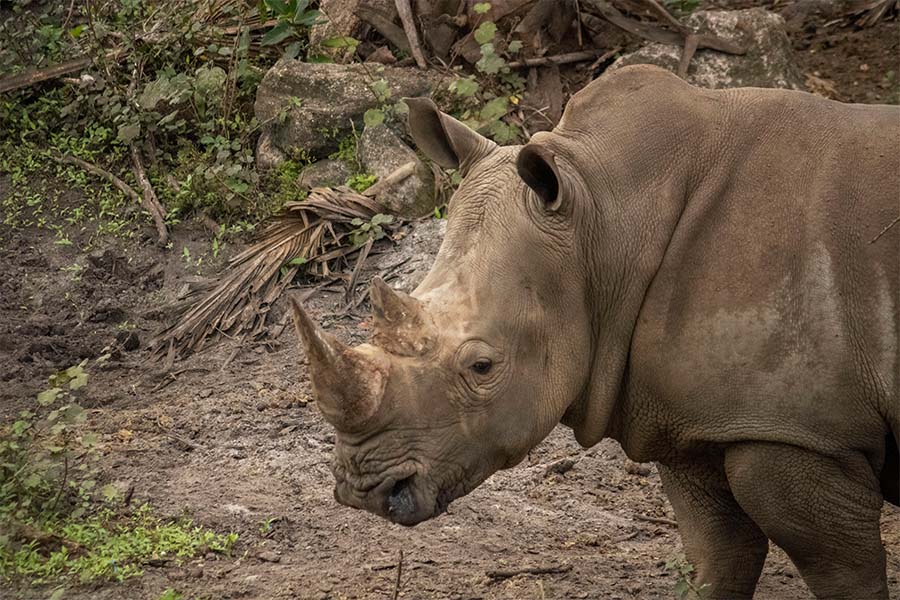Summary of Using Science to Breed Our Rhinos: A Bittersweet Ending:
The article discusses the conclusion of a series of blogs documenting the use of artificial insemination (AI) on female Southern white rhinoceroses at Brevard Zoo. The zoo had hoped that the AI process would result in the birth of baby rhinos and contribute to understanding the species. However, after months of collaborative efforts, it was discovered that one of the rhinos, 21-year-old Kibibi, was not pregnant. Despite this outcome, the zoo believes that the knowledge gained through the AI process is invaluable for conserving white rhinos. The zoo initially attempted AI with another female rhino, Uzuri, but she eventually refused to participate. The zoo plans to continue caring for the rhinos and contribute to research and conservation efforts for white rhinos.
– Brevard Zoo has been using artificial insemination (AI) to breed Southern white rhinoceroses.
– After many months of effort, they have learned that one of their female rhinos, Kibibi, is not pregnant.
– Despite this, the knowledge gained from the AI process will contribute to the understanding and conservation of white rhinos.
– The zoo has no plans for further AI at this time but will continue to provide a high quality of life for their rhinos.
In a bittersweet conclusion to a year-long journey, Brevard Zoo has announced that their female Southern white rhinoceros, Kibibi, is not pregnant after undergoing artificial insemination (AI). While the news may be disappointing, the zoo emphasizes the invaluable knowledge gained throughout the AI process and its positive impact on the understanding and conservation of white rhinos.
Since 2003, the zoo has been home to a group of southern white rhinoceroses, including Kibibi and her fellow female rhino, Uzuri. Initially, the hope was that these rhinos would conceive naturally, but when that proved unsuccessful, the decision was made to turn to AI. This assisted reproductive technology, commonly used in humans and animals, involves depositing stored semen directly into the female’s uterus to increase the chances of conception.
As an Association of Zoos and Aquariums (AZA) accredited facility, Brevard Zoo is dedicated to the care of the animals within its walls and the conservation of wildlife worldwide. AI was a proactive measure to support the population of white rhinos and ensure long-term genetic diversity.
In collaboration with the not-for-profit group SEZARC and leading scientists from Omaha’s Henry Doorly Zoo and Aquarium, Taronga Conservation Society in Australia, and SeaWorld Entertainment, Inc., Brevard Zoo embarked on a study funded by the Institute of Museum and Library Services. This study aimed to develop a protocol for AI that would benefit the sustainability of the white rhinoceros population.
The AI process began with Uzuri and Kibibi undergoing testing and becoming comfortable with a custom chute, a safe space for the procedure. They also spent more time in this area and voluntarily stood for ultrasounds. Based on their training and testing, the zoo initially received the go-ahead to proceed with Uzuri.
Uzuri willingly participated in the AI process for several months. However, as the procedure was voluntary, she no longer wanted to continue. Respecting her choice, the zoo gave Uzuri and Kibibi a break before attempting AI again.
Late in 2022, the decision was made to focus on Kibibi for the next round of AI. Despite her underlying reproductive issues, Kibibi remained motivated and willingly participated in all scheduled ultrasounds. In January 2023, the process to trigger ovulation began, and as Kibibi’s dominant follicle matured, ultrasounds increased in frequency until ovulation was documented.
On the day of insemination in mid-February 2023, SEZARC was on site to perform the AI procedure. Kibibi underwent regular ultrasounds until ovulation was confirmed, at which point she was sedated and artificially inseminated using a catheter. The veterinary team closely monitored Kibibi, checking hormone levels weekly and looking for signs of pregnancy.
Unfortunately, after careful monitoring, it has been confirmed that Kibibi is not pregnant. While this is not the desired outcome, the knowledge gained from the AI process is still of immense value. Brevard Zoo veterinarian Dr. Kyle Donnelly emphasizes that being part of this collaborative study contributes to the overall understanding of white rhino reproduction and supports their conservation goals.
Additionally, the AI process provided a unique opportunity to capture ultrasound images of Kibibi’s ovulation, which had never been documented before. This adds to the existing body of knowledge on rhino reproduction and aids in the conservation efforts for the species.
Looking ahead, Brevard Zoo has no plans for further AI with Uzuri or Kibibi. The focus will remain on providing a high quality of life for these rhinos, who will continue to live with their male companion, Frankie, in the Expedition Africa section of the zoo. While female rhinos can reproduce until their late 40s, the lack of success in previous attempts suggests a low possibility of conception.
Despite the outcome, Brevard Zoo remains committed to contributing to white rhino research and conservation efforts in any way possible. Careful attention will be given to ensuring the physical, mental, and emotional health of Uzuri and Kibibi throughout their lives at the zoo. This includes providing comprehensive veterinary care, a balanced diet, positive reinforcement training, meaningful choices, and an enriching environment.
In conclusion, while the AI journey may not have resulted in a pregnancy for Kibibi, the knowledge gained through this process is invaluable. Brevard Zoo’s participation in the collaborative study and its commitment to the conservation of white rhinos demonstrates the dedication of zoos and wildlife organizations to protecting endangered species and preserving genetic diversity.

